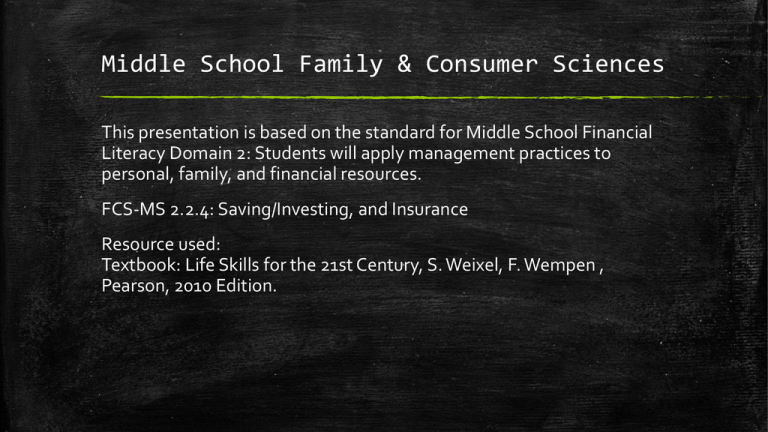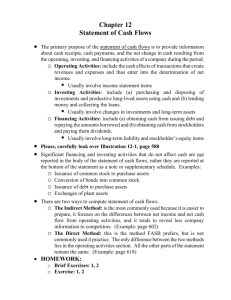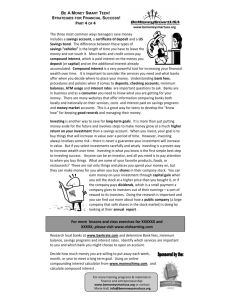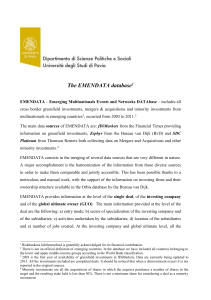Savings & Investing PowerPoint - EDCI 360 Financial literacy
advertisement

Middle School Family & Consumer Sciences This presentation is based on the standard for Middle School Financial Literacy Domain 2: Students will apply management practices to personal, family, and financial resources. FCS-MS 2.2.4: Saving/Investing, and Insurance Resource used: Textbook: Life Skills for the 21st Century, S. Weixel, F. Wempen , Pearson, 2010 Edition. Savings Tevin Shoultz, Purdue University EDCI 360, Spring 2015 tshoultz@purdue.edu What is savings? ▪ The portion of your current income not spent and placed in a savings account. Why do we save? ▪ In case of emergencies ▪ Traveling ▪ Buying a home and/or car ▪ Special Occasions – Graduation ▪ Future Endeavors – College What are the best ways to save? ▪ Pay Yourself First! – Placing a specific amount of money in a savings account deposited in either a bank or credit union. ▪ Investments! Pay Yourself First ▪ When an individual has a specific savings amount from each paycheck, deposited into their savings account. Opening a savings account is the most safest and most reliable way to save your money. Types of savings accounts: ▪ 3 different types of savings accounts: – Passbook Accounts: The most standard type of savings account. – Time Accounts: Savings accounts that require you to leave your money untouched for a certain amount of time. ▪ Certificate of Deposit (CDs) – Money Markets: Offer a higher interest rate than a passbook account. They have a higher minimum balance, and limit the number of times per month withdrawals can be made. NOTE: Your savings is insured by the FDIC. That means is something happens to the bank, then government will reimburse you that money. What is interest? ▪ Money you can earn for opening a savings account at a bank/credit union. – Simple interest – Compound interest ▪ Think of interest as free money from your bank. Example: – In August of her senior year, Lori started working at the local grocery store. With working 20 hours a week and makes $8.00 an hour. She brings home roughly $130, after taxes. Lori is saving all the money she can before she leaves for college in August. After deep thought, she figured out that she could save $80 a week and have it deposited directly into her savings account. After saving for 12 months (52 weeks), Lori saved $4160, before earning interest from her bank. Now to figure earnings from interest ▪ Most accounts you might have earn simple interest. – Lori’s bank gave her an interest rate of 3%. Since she saved for 1 year, we can figure out how much interest she could earn after 1 year. –We follow the simple formula: ▪ Simple Interest= Principal x interest x time –Plug & chug the relevant information! ▪ Simple Interest = $4160 x .03 x 1= 124.80 Interest continued… ▪ Suppose Layton had received money from his Sweet 16 birthday party. He had gotten a total of $500. He decided to put the money into a savings account earning simple interest, until he was 18. The savings account earned him 2% interest. What is the value of the account on his 18th birthday? ▪ What do we do? 1. 2. 3. 4. 5. Pull out the important information! “Plug and chug” along into the formula. SI=Principal x Interest x Time SI=500 x .02 x 2 Interest = $20.00 Total: $520.00 Another way to grow your money is through investing. You can do this by investing a portion of your savings to grow your ROI—return on investment. It’s a lot more risky, but can be a great way to grow your money for the future. Investing is a gamble. It is not insured. Be prepared to lose money sometime/somehow when investing. ▪ Two basic types of investments are: 1. 2. Equity Investments Fixed Income Investments The type of equity investments available to investors are buying stock in a company. Stock is a form of ownership in a company, but you don’t have any owner’s rights to the company. If the company’s stock price rises and you’re invested in it, then you’ve made money! One of the hardest decisions is to decide to keep the stock and gamble to make more money, or risk losing it. Market Watch Example! So what do the numbers mean? ▪ AAPL- Apple – 4 shares purchased at $127.39 – 6 shares purchased at $128.13 – After opening of the market day, I had earned $1.06 per share. I can chose to sell the stocks at any time, or I can play a gamble and hope to have a better return on my investment. ▪ Apple’s stock went down to $126.85 – This shows how earnings can fluctuate on a daily basis. – Investing in the stock market is a gamble, but a great way to build up financial capital and a higher return on investment. ▪ BioTime-BTX – There was a gain from $5.51 to $5.76. – .25 cent gain, for 15 shares earning $3.75 today. ▪ You are lending your money to a business/government agency in place for a bond. – Bonds are securities that provide fixed interest payments for a set period of time. – The company is making a vow that they will pay you interest during your period of time. Once the maturity date has been reached you will be paid back your principal. – So why do it? ▪ It’s much safer!!! – You are guaranteed a return and most bonds are insured. ▪ A pool of money that has been collected from a group of many investors. – They use the money to buy stocks, bonds, & other types of securities. – Investments in many companies, building a better return! • Easy to create liquidity. • You can sell your shares at anytime! • A professional is doing the investing for you!




